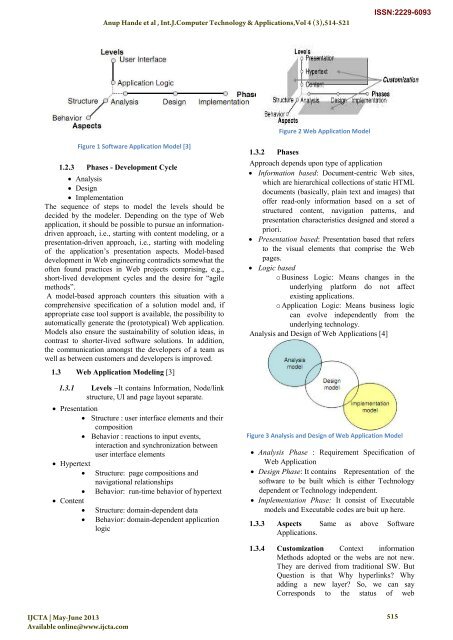Survey of Existing Web Models Techniques to Design Web Application
Survey of Existing Web Models Techniques to Design Web Application
Survey of Existing Web Models Techniques to Design Web Application
You also want an ePaper? Increase the reach of your titles
YUMPU automatically turns print PDFs into web optimized ePapers that Google loves.
Anup Hande et al , Int.J.Computer Technology & <strong>Application</strong>s,Vol 4 (3),514-521<br />
ISSN:2229-6093<br />
Figure 2 <strong>Web</strong> <strong>Application</strong> Model<br />
Figure 1 S<strong>of</strong>tware <strong>Application</strong> Model [3]<br />
1.2.3 Phases - Development Cycle<br />
• Analysis<br />
• <strong>Design</strong><br />
• Implementation<br />
The sequence <strong>of</strong> steps <strong>to</strong> model the levels should be<br />
decided by the modeler. Depending on the type <strong>of</strong> <strong>Web</strong><br />
application, it should be possible <strong>to</strong> pursue an informationdriven<br />
approach, i.e., starting with content modeling, or a<br />
presentation-driven approach, i.e., starting with modeling<br />
<strong>of</strong> the application’s presentation aspects. Model-based<br />
development in <strong>Web</strong> engineering contradicts somewhat the<br />
<strong>of</strong>ten found practices in <strong>Web</strong> projects comprising, e.g.,<br />
short-lived development cycles and the desire for “agile<br />
methods”.<br />
A model-based approach counters this situation with a<br />
comprehensive specification <strong>of</strong> a solution model and, if<br />
appropriate case <strong>to</strong>ol support is available, the possibility <strong>to</strong><br />
au<strong>to</strong>matically generate the (pro<strong>to</strong>typical) <strong>Web</strong> application.<br />
<strong>Models</strong> also ensure the sustainability <strong>of</strong> solution ideas, in<br />
contrast <strong>to</strong> shorter-lived s<strong>of</strong>tware solutions. In addition,<br />
the communication amongst the developers <strong>of</strong> a team as<br />
well as between cus<strong>to</strong>mers and developers is improved.<br />
1.3.2 Phases<br />
Approach depends upon type <strong>of</strong> application<br />
• Information based: Document-centric <strong>Web</strong> sites,<br />
which are hierarchical collections <strong>of</strong> static HTML<br />
documents (basically, plain text and images) that<br />
<strong>of</strong>fer read-only information based on a set <strong>of</strong><br />
structured content, navigation patterns, and<br />
presentation characteristics designed and s<strong>to</strong>red a<br />
priori.<br />
• Presentation based: Presentation based that refers<br />
<strong>to</strong> the visual elements that comprise the <strong>Web</strong><br />
pages.<br />
• Logic based<br />
o Business Logic: Means changes in the<br />
underlying platform do not affect<br />
existing applications.<br />
o <strong>Application</strong> Logic: Means business logic<br />
can evolve independently from the<br />
underlying technology.<br />
Analysis and <strong>Design</strong> <strong>of</strong> <strong>Web</strong> <strong>Application</strong>s [4]<br />
1.3 <strong>Web</strong> <strong>Application</strong> Modeling [3]<br />
1.3.1 Levels –It contains Information, Node/link<br />
structure, UI and page layout separate.<br />
• Presentation<br />
• Structure : user interface elements and their<br />
composition<br />
• Behavior : reactions <strong>to</strong> input events,<br />
interaction and synchronization between<br />
user interface elements<br />
• Hypertext<br />
• Structure: page compositions and<br />
navigational relationships<br />
• Behavior: run-time behavior <strong>of</strong> hypertext<br />
• Content<br />
• Structure: domain-dependent data<br />
• Behavior: domain-dependent application<br />
logic<br />
Figure 3 Analysis and <strong>Design</strong> <strong>of</strong> <strong>Web</strong> <strong>Application</strong> Model<br />
• Analysis Phase : Requirement Specification <strong>of</strong><br />
<strong>Web</strong> <strong>Application</strong><br />
• <strong>Design</strong> Phase: It contains Representation <strong>of</strong> the<br />
s<strong>of</strong>tware <strong>to</strong> be built which is either Technology<br />
dependent or Technology independent.<br />
• Implementation Phase: It consist <strong>of</strong> Executable<br />
models and Executable codes are buit up here.<br />
1.3.3 Aspects Same as above S<strong>of</strong>tware<br />
<strong>Application</strong>s.<br />
1.3.4 Cus<strong>to</strong>mization Context information<br />
Methods adopted or the webs are not new.<br />
They are derived from traditional SW. But<br />
Question is that Why hyperlinks? Why<br />
adding a new layer? So, we can say<br />
Corresponds <strong>to</strong> the status <strong>of</strong> web<br />
IJCTA | May-June 2013<br />
Available online@www.ijcta.com<br />
515
















